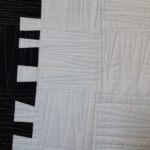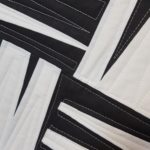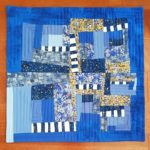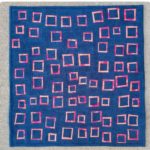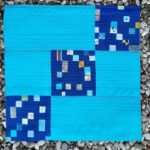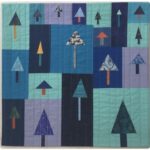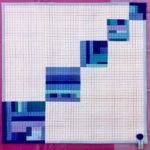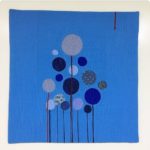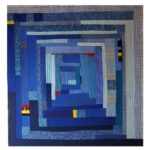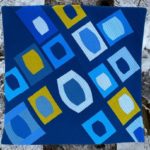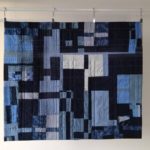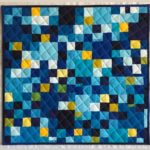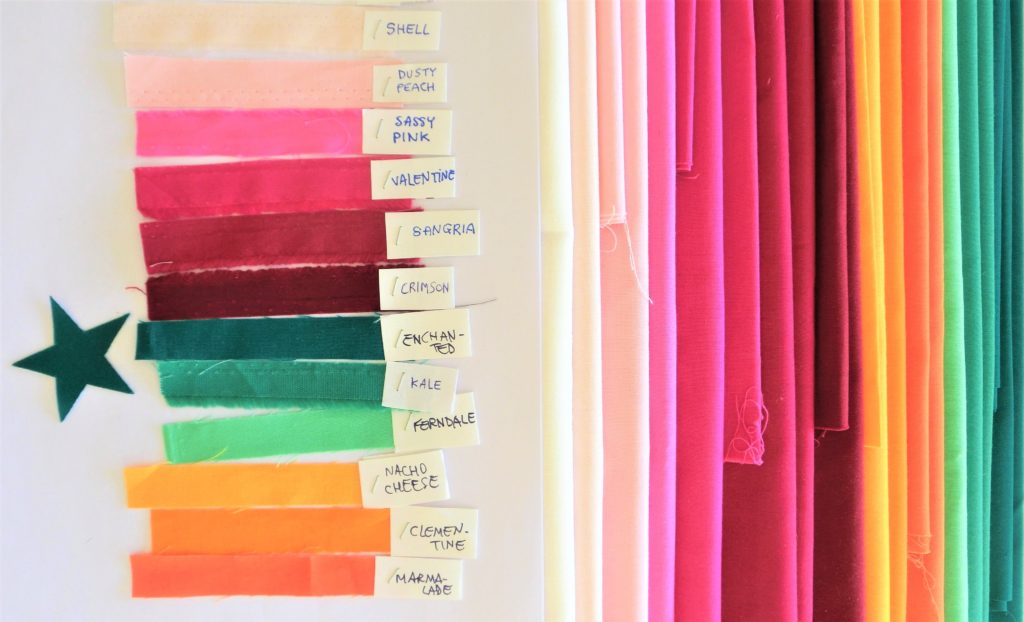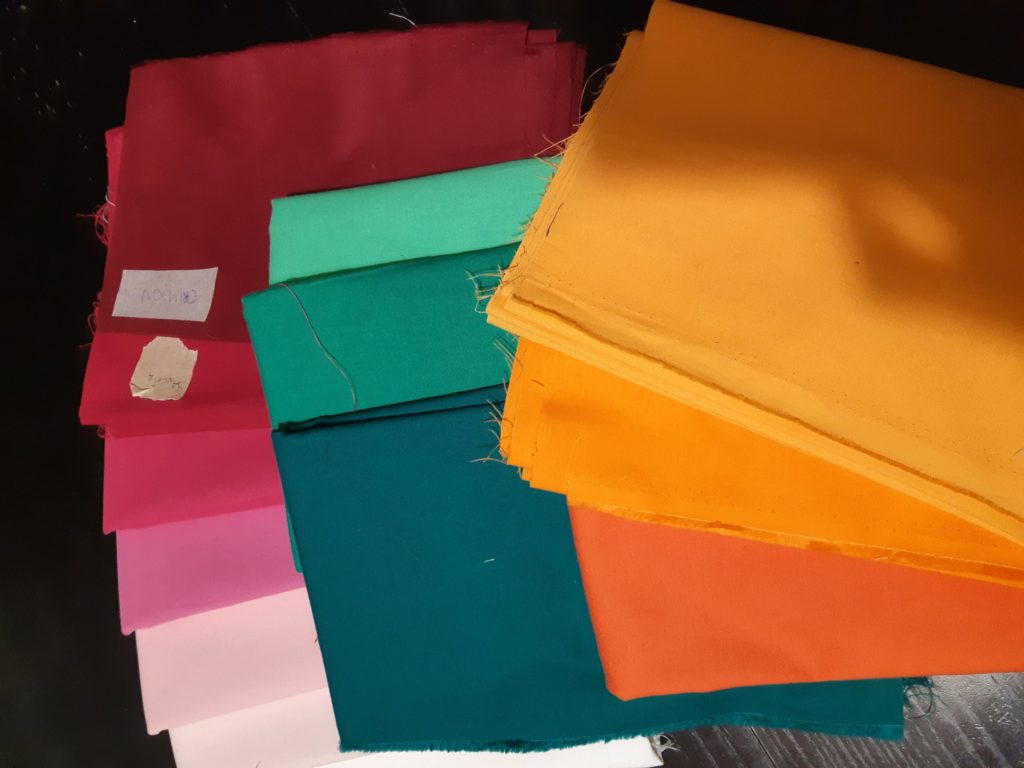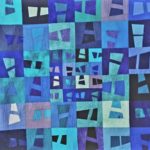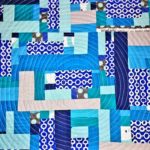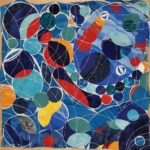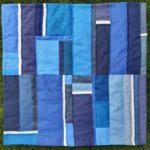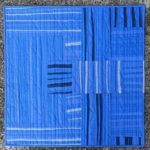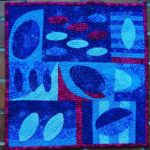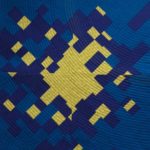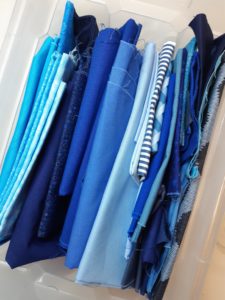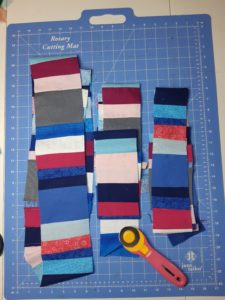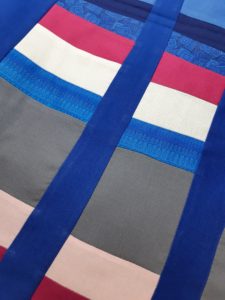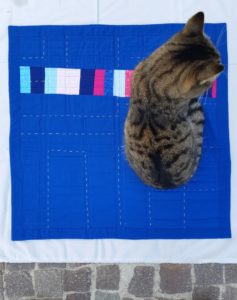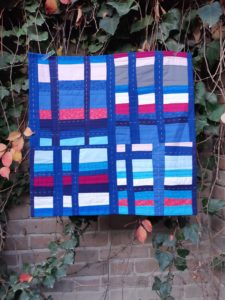You know that our virtual “studio” wants to be a meeting place to learn or to practice together, by sharing our personal experiences. Thus, we asked a few questions to the first participants of the Blue Improv Repetition challenge, who surprised us by finishing the game in a very short time.
The questions we asked are focused on the various stages of production and on personal preferences of the creative process. We started with the choice of the palette: having a color already defined, how did you decide to add the others?
@quilter_man58 started with a precise idea of what he wanted to realize: “distant galaxies”. Thus, he was guided by the title and he chose the colors present in the universe: yellow, red, orange, white and black, all present in the planets, in the sun, in the Milky Way..
@patchbri pulled out all the blues she had, and she was amazed by how many they were!
@silviafic8 immediately thought of the yellow fabric she wanted to use. It was a little piece of yellow she was saving for something special, because she likes it so much”
@blabshandgemacht, who currently lives in a country far from her own, had a limited amount of fabric with her, so she used the scraps she had decided to bring with her last summer: everything she had in blue, her favorite color. That, together with ripped shirts and leftovers from other projects, made a nice selection of blues for this little quilt.
@morphea80 doesn’t use blue very often in her quilting projects. But blue it had to be this time. Luckily she had some greyish blue in her stash. She added some green, dark red, yellow and white to it, just because this color combination reminded her of a crisp sunny autumn day.
@nensipamela said that blue and its derivatives inspire her a lot in this period: even if it is not her first color choice (she likes more purple derivatives), nevertheless she has accumulated a series of fabrics in shades of blue and teal that were just waiting to come out of their box. So it was easy for her to draw on these colors, perhaps a bit randomly, but trying to make a mix that is pleasing to the eye.
@aquilterstable chose her palette based on her exploration of “Classic Blue”: the 2020 Pantone Color of the Year! She described this idea well in an article on her blog (you can find it at this link ). Even if she considered adding other colors, she decided to stick with shades of blue, from lighter to darker than the Classic Blue.
The blue palette has always been one of @mariurbezg’s favourites. So, when she saw that the new game would be around blue fabrics, she decided immediately to participate, but she needed another colour to give more light to the quilt. She choose a bright fuchsia for that.
From these first answers we already understand the variety and freedom that improv patchwork allows: you can use your favorite colors, work with what you have available by adding fabrics not strictly made to become a quilt, and you can also invent an unconventional blue.
Stonhenge by @nensipamela
Galassie lontane by @quilter-man58
The second parameter of the challenge was to use a shape of own choice, repeating and modifying it as desired. Also in this case we can proceed in different ways, let’s find out how our friends have designed their work in this context: you will see how varied are the ways for each one to construct their own vision!
@quilter_man58, for the shape choice, took inspiration from the stars and from all the shapes present in the cosmos, with their own deformations due to explosions, collisions and mergers.
@patchbri started sketching, and so she came up with the letter A, the initial of the names of her grandchildren. She continued doing more of it, until she achieved what she wanted to accomplish.
@silviafic8 first decided that the shape to be repeated was the stripe. When deciding on the layout, she thought that placing them horizontally or vertically would be obvious, so she stitched them diagonally. Her composition resulted from making 4 blocks in the same way.
@blabshandgemacht once saw a very geometrical pattern in the background of a video. Inspired by that, she sketched a few patterns out of her mind, so that it could work for a quilt in the future. It happened to be rectangles, only in many different sizes. And this work matched the criteria of the game.
@morphea80 told us that, since some of the fabrics were already cut in strips, she decided to use this form to play with. As always, when sewing improv, she didn’t have a plan: her choice was rather focused on the technique to work with. Here she started with two bigger pieces of fabrics sewn together with a strip of different color. Then she cut this block once, turned around one piece by 180 degrees and joined both pieces, again with a contrasting strip in between. She repeated this process a couple of times.
For @nensipamela the choice of the shape to be repeated was the most difficult part. A lot of them came into her mind, but by the time she went to the cutting mat, none of them helped her. She started cutting and assembling, initially forming small blocks which she cut several times. The blocks that came out became the shape to be repeated. The repetition process was also an improv process… at a certain point the piece seemed finished to her, and so she finished her quilt.
@aquilterstable loves improvisational stripes: she was inspired to use them again after finishing her recent “Vista Toscana.” She continued to explore the concept of stripes ‘wrapping around’ another segment of stripes. She repeated the wrapping concept multiple times while playing with different scales.
@mariurbezg started playing with curves: she always loves them. She decided that she should work with ellipses, even if her first idea was for circles. In the end she was very happy with this change.
Und nun by @ blabshandgemacht
Utterly blue by @aquiltertable
The last question was aimed at knowing the preferences on the various stages of creating a quilt. Even if it’s a hobby, or a job for someone, it’s not always fun. There are things we love to do and to enjoy, or to relax with, and others we would like to avoid. Let’s see what they replied about it:
@quilter_man58 has no moments he loves less in the creative process, but the ones he appreciates because they gratify him most, are the construction of the shapes and the quilting.
For @patchbri it is always difficult to find what to do, where to start, and how to interpret the starting points. Once she’ve found this, it’s relatively easy to get on with the work.
@silviafic8 mainly likes to imagine, to think how the result could be, after choosing the fabrics. She likes to do improv patchwork, but she also thinks about the meaning to give to her work. In reality, it may happen that in the implementation phase there is something different than the initial idea. What she loves less is cutting and sewing fabrics.
@blabshandgemacht really enjoys going through her fabrics and choosing the colors, especially how they are nicely playing together. She did not like the size of the quilt since she didn’t see the functionality of such a small piece. This is why she called it “UND NUN” (and now) because she doesn’t know what to use it for, other than looking at it (but enjoying it).
For @nensipamela the favorite part of the creative process is choosing the palette. Usually she starts from a color that inspires her in that moment, and from which she would like to be surrounded. In recent years she has been lucky to have visited some Nordic countries, which are influencing her, and transporting her towards a choice of cold and bright colors. The part she feels less comfortable with in the creative process is being able to match the chosen color to a shape that can enhance it.
Figuring it out the result, as long as she goes on, is especially fun for @aquilterstable: the “building” part of the process is her preferred part. Sometimes she gets ‘stuck’ in the process, and she struggles with that, thinking about the possibilities for days. But in the end that struggle leads her forward.
Quilting always plays a particular role in the overall work: and we are all different about it. See below!
@morphea80 told us that the part she likes most is choosing the technique before starting to sew; and then, she loves the piecing. She doesn’t enjoy quilting that much, because she easily gets bored with it. But with a mini quilt the amount of quilting is okay!
@mariurbezg had some problems piecing the tighter curves and that was the part she enjoyed less, but at the end she could manage them. On the other hand, her favourite part was quilting. It’s always nice to work with small quilts where you have more freedom to select a complicated pattern for the quilting.
Profundidad by @mariurbezg
Blueimprovrepetition by @silviafic8
Blue Improv repetition continues, and you can send pictures of your works until January 10th, 2021. A nice way to spend the coming Season holidays at home!
We want to conclude by saying thanks to our friends who have already finished their quilt, for the availability in answering our questions, thus helping us to get to know each other, to grow as a group. A spontaneous, free and open group, united by the same passion, the desire to try, to get involved. Even if we are in a particular period, which increases distances, it seems precious to us to have opportunities to share these little moments, even if only in virtual mode.
See you soon!
Giovanna, Carla and Paola.
